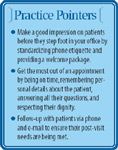- Benign Prostatic Hyperplasia
- Hormone Therapy
- Genomic Testing
- Next-Generation Imaging
- UTUC
- OAB and Incontinence
- Genitourinary Cancers
- Kidney Cancer
- Men's Health
- Pediatrics
- Female Urology
- Sexual Dysfunction
- Kidney Stones
- Urologic Surgery
- Bladder Cancer
- Benign Conditions
- Prostate Cancer
How to enhance patients' experience with you: 11 steps
These simple pointers can help keep your patients happy and, consequently, healthy

1. Establish phone etiquette. The first interaction that most patients will have with you and your practice will be via the telephone. There is a world of difference between "Doctor's office. Please hold," and, "This is Dr. Baum's office. This is Nicole speaking. How may I help you?"

The welcome package should include your practice brochure, a map and directions to your practice, information about parking in the area, educational materials related to the patient's chief complaint, expectations regarding payment, a patient history questionnaire, the demographic information that you will need at the time of the first visit, the importance of obtaining authorization from a primary care physician, and what to expect on a first visit. Examples of the latter include your request to obtain a voided specimen for a urinalysis and your recommendation that patients increase their fluid consumption and be prepared to give a specimen at the time of their arrival in the office.
3. See patients on time. There is no better way to endear yourself to your patients than by being regarded as an on-time physician. In the past, patients were willing to wait 30 to 60 minutes or more to see their urologist. Today, patients are tapping on the window after 15 minutes in the reception area if they haven't been escorted to the exam room. Make effective and efficient scheduling a priority for your practice and you will find that you can become a very busy physician without staff burnout and without making patients angry and defensive even before you discuss their urologic problem.
4. Make use of social progress notes. You want your patients to feel that you care more about them than their genitourinary organs. The best way to accomplish this is using social progress notes. This can be located on the left-hand side of the chart or in a separate tab on your electronic medical record. Social progress notes include areas of interest, hobbies, children, grandchildren, and occupational history. These can be recorded by the physician or the staff in the chart.
When you see the patient again, you will impress him by mentioning his recent trip to the Caribbean, his accolades, and his children's accomplishments. Patients don't care how much you know until they know how much you care. The best way to show that you care is to use social progress notes.
